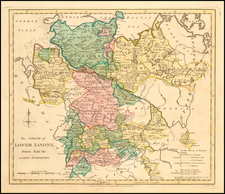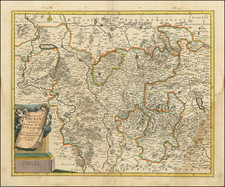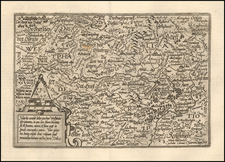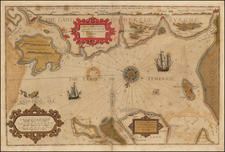Hanseatic Bremen
Finely crafted plan and view of Bremen, offering a detailed glimpse of Bremen in the early 18th century.
Created around 1720, this colored copperplate map boasts of meticulous craftsmanship synonymous with Homann's works. The title itself hints at the imperial significance of Bremen, an independent "Reich" or empire city and a member of the Hanseatic League, an influential confederation of merchant guilds and their market towns.
Below the map, one is treated to an expansive bird's eye view of the city, a panorama stretching across the Weser River. Such a perspective not only showcases the urban sprawl but also accentuates the fortified boundaries, architectural marvels, and the intertwining waterways of the city.
Enhancing the visual appeal, the map is framed with two intricately designed vignettes replete with figurative allegories. Of note is the depiction of the God Mercury, symbolizing commerce, which pays homage to Bremen's prominence as a trade hub. Topping off the map's elegance is the city's coat of arms, proudly presiding over the entire view.
Places of Historical Significance
The map is a veritable guide to Bremen's urban landscape during the 18th century. The following sites, among others, are prominently showcased:
- Die Neuftadt: Likely referring to the 'New City' or the newer part of Bremen.
- Das Hoche Thor, Das Bunte Thor: Various city gates that controlled entry and exit, crucial for defense and trade.
- Die kirch, Haubtwacht, Ball hauss: Central places of worship, the main guard, and a probable assembly or dance hall.
- Hoche Straß, GruneStr: Major streets or thoroughfares in the city.
- Teerhoff, Die Braut, Alt Stadt: Various districts or neighborhoods.
- Ofter Thor, St Iohannis Clost, Thums Heyde: Eastern gate, St. John's Monastery, and possibly a heath or park area.
- Der Thum St.Petrj, Thums hoff: The cathedral dedicated to St. Peter and its courtyard.
- Marck, Rathhu, Boerss: The market, city hall, and the exchange – essential hubs of trade and governance.
- Unf: Lieb Fr Kirch, Catha Kirch, Zeugh: u: schul: Various churches and likely a school or an arsenal.
- Herten Thor, Martins Kirch: Another gate and St. Martin's Church.
- Die Schlachte: A historic promenade along the Weser river.
- St: Angfari Thor, St Angfary Kirch, S. Nicolaj Kirch: City gates and churches dedicated to saints.
- Schützen wall: Likely a fortified wall or rampart.
- Taube Th, St Stephani Kirch u: Schul, Stephans Thor: A gate, St. Stephen's Church and school.
- Armen hauß, Zucht hauss: Alms-house and probably a house of correction.
- Marien Kirch, Gotts Acker: St. Mary's Church and a cemetery.
- Wasser Rad, SRömers, undoveser Bruck: Waterwheel, a notable residence, and a bridge over the Weser.
Johann Baptist Homann (1663-1724) was a mapmaker who founded the famous Homann Heirs publishing company. He lived his entire life in Bavaria, particularly in Nuremberg. Initially, Johann trained to become a priest before converting to Protestantism and working as a notary.
In 1702, Johann founded a publishing house that specialized in engravings. The firm flourished, becoming the leading map publisher in Germany and an important entity in the European map market. In 1715, Johann was named Imperial Geographer to the Holy Roman Empire by Charles VI and made a member of the Prussian Academy of Sciences. Most importantly for his business, his reputation and contacts gained him imperial printing privileges which protected his publications and recommended him to customers. Johann is best known for this Grosser Atlas ueber die ganze Welt, or the Grand Atlas of the World, published in 1716.
After Johann died in 1724, the business passed to his son, Christoph (1703-1730). Upon Christoph’s early death, the company passed to subsequent heirs, with the name of the company changing to Homann Erben, or Homann Heirs. The firm continued in business until 1848.












![[ Jülich Kleve ] De Hertochdommen Gulick Cleve Berghe en de Graeffchappen vander Marck en Ravensbergh . . . 1610](https://storage.googleapis.com/raremaps/img/small/99226.jpg)
![Chart of the North and Baltic Seas [insets of St. Petersburg, Heligoland and Revel]](https://storage.googleapis.com/raremaps/img/small/72115.jpg)
